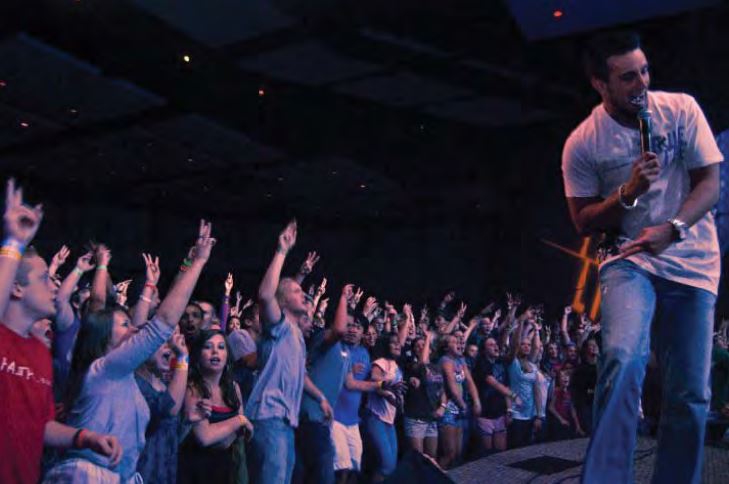The Basement borrows from a religious past and adjusts it to fit the spiritual needs of contemporary southern Christians. Instead of simply rejecting the old order and completely uprooting religious practices, megachurches like The Basement transform somewhat staid spiritual traditions into more palatable religious expressions for their mostly middle-class, suburban congregants. For instance, Matt Pitt’s preaching has been characterized as a “vocal machine gun,” but it retains a cadence that mimics that of famous revivalist preachers of American religious history. After he attempts to moonwalk like Michael Jackson across the stage, Pitt shifts into a different role. He claims that as God was growing The Basement, God was also making him into “an evangelist” and the “ministry into a high intense evangelism ministry.” Like George Whitefield of Great Awakening renown, Pitt uses emotive language to prod sinners towards deliverance. He draws on the power of preachers like Billy Sunday, relating a spiritual message to temporal examples that are uncomplicated and easy to understand. Sunday used baseball as a spiritual analogy; Pitt uses SEC football, secular music, and MTV-influenced videos to promote his message. Borrowing from the practices of Aimee Semple McPherson, he also relies on modern technology to project his ideas to any and all who will listen. In one spontaneous moment, these various evangelical forces converge on The Basement stage.
With strobe lights flashing and video cameras rolling, Pitt engages his followers in a call and response routine shaped from evangelical ritual:
Pitt: “Here at The Basement, we are not perfect, we are just...”
Audience: “FORGIVEN!”
Pitt: “We are just...”
Audience: “FORGIVEN!”
Pitt: “We are just...”
Audience: “FORGIVEN!”
The Basement bills itself as the “HOTTEST CLUB around,” but it is more than a club; it shares a spirit with past religious movements and the liturgy that it uses is founded on the legacies of those movements.
The Basement borrows from a religious past and adjusts it to fit the spiritual needs of contemporary southern Christians. Instead of simply rejecting the old order and completely uprooting religious practices, megachurches like The Basement transform somewhat staid spiritual traditions into more palatable religious expressions for their mostly middle-class, suburban congregants.
Since proselytizing for these religious reforms, Hybels has actually reconsidered his original beliefs regarding the “seeker-sensitive” system, reaching the conclusion in a 2007 study that contemporary Christians needed not merely excitement but long-term spiritual development. Matt Pitt, however, has taken the “seeker-sensitive” model to the extreme with the establishment of Whosoever Ministries, a religious organization that aims to bring in unchurched young adults by “competing with clubs and bars for souls.” The twenty-something pastor explains, “the only reason that this MTV generation continues to wander aimlessly toward the darkness that the club lights have to offer is because they are bored out of their minds.”
As it draws from national megachurch trends, The Basement also responds to the cultural context of the state in which it thrives. Alabama has a convoluted and constantly evolving evangelical heritage. Before the Civil War, many slaves and slave owners converted to evangelical Protestantism but interpreted their new faith in widely different ways—either as a symbol of freedom or a mechanism of control. In the twentieth century, significant civil rights ministers—Martin Luther King Jr., Fred Shuttlesworth, Joseph Lowery, and Ralph Abernathy—hailed from Alabama and applied biblical teachings to break the bonds of segregation and white supremacy. Now, fifty years later, Pitt runs a diverse congregation and the leadership of the church reflects the attempt to construct a “post racial” environment. Pyrotechnics and rap music connect e Basement to the national megachurch aesthetic, but its blended demographic is making a very real regional impact. Ultimately, by creating a new style of evangelicalism and worship for a changing world, Matt Pitt and The Basement are continuing the tradition of two centuries.
This feature was previously published in Issue 100, Spring 2011.
Author
Charity R. Carney received a PhD from the University of Alabama, is the author of the forthcoming book Ministers and Masters: Methodism, Manhood, and Honor in the Old South (LSU Press, 2011), and currently is developing
a second book on the modern megachurch. Joshua D. Roth- man, standing editor of the “Southern Religion” department of Alabama Heritage, is associate professor of history at the University of Alabama and director of the university’s Frances S. Summersell Center for the Study of the South, which sponsors this department.

 RSS Feed
RSS Feed